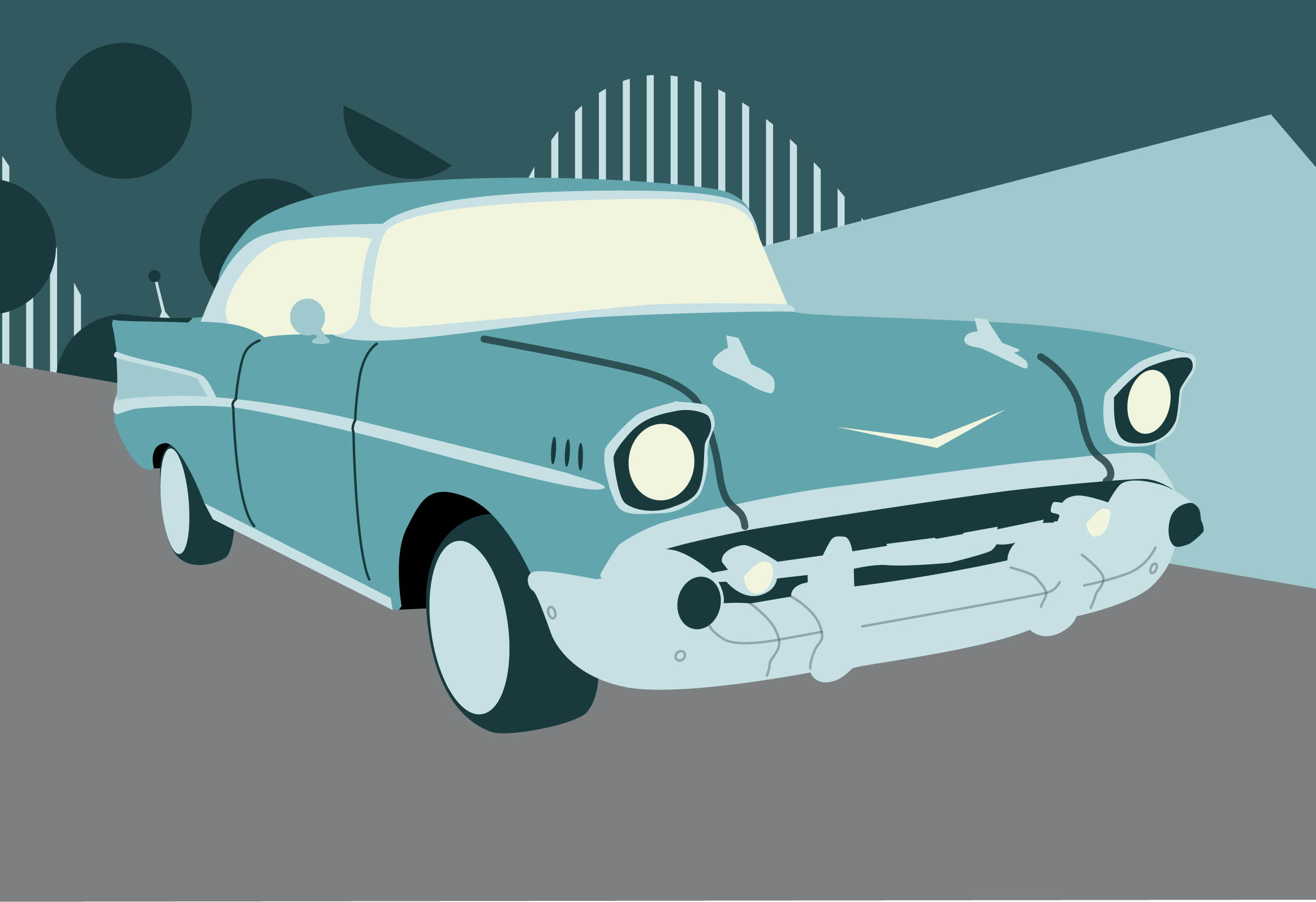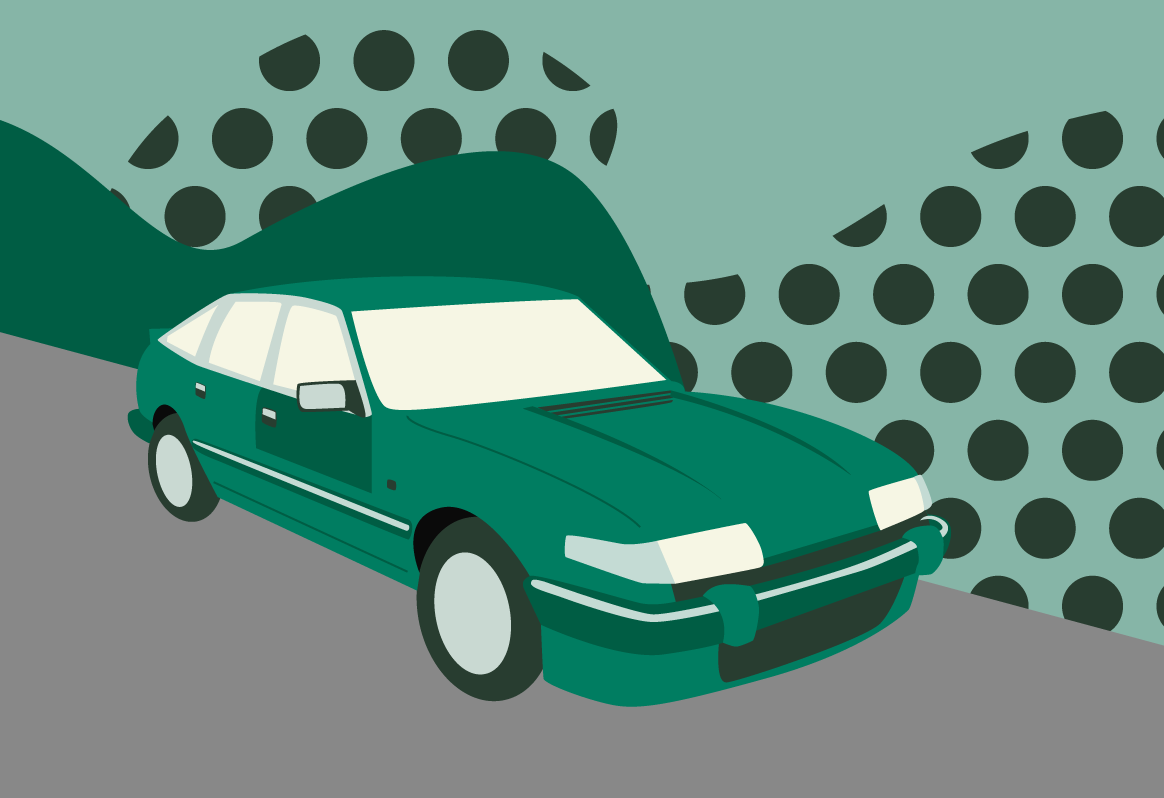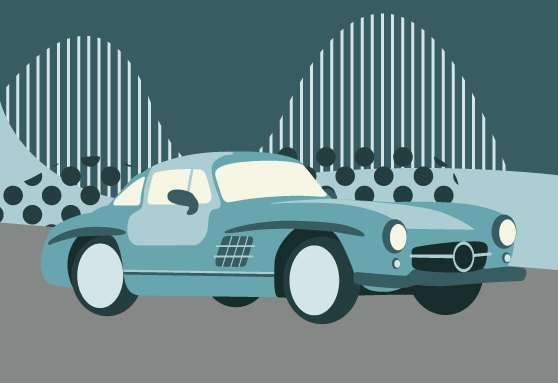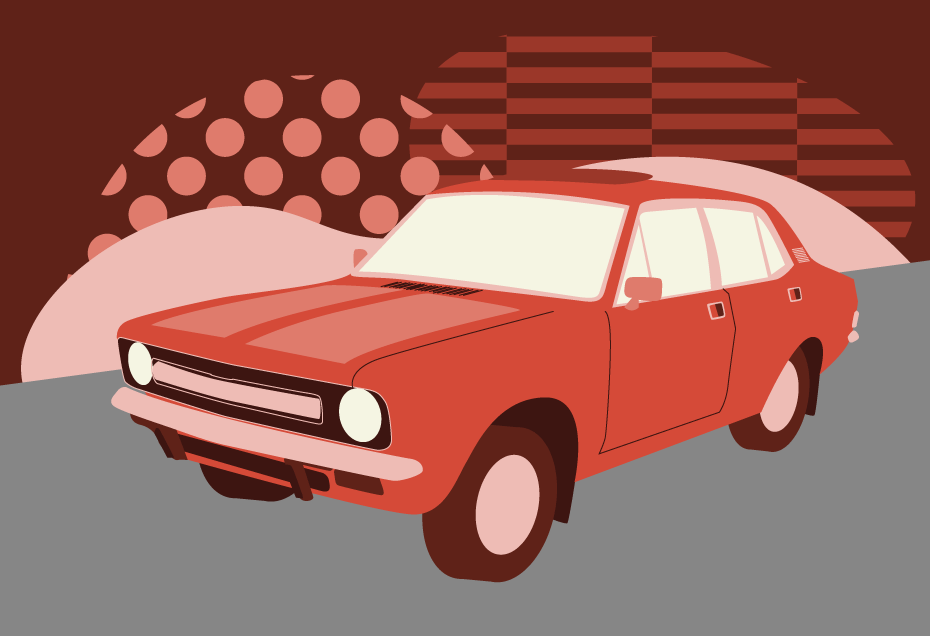It’s as American as apple pie, rock ‘n’ roll and baseball, an epochal symbol of the nation’s postwar middle class prosperity.
The Chevrolet Bel Air of ‘55 to ‘57 – and its siblings in the Tri-Five series – struck a chord in middle America that still resonates today.
This is the story of a car that proved a watershed for Chevrolet, and encapsulated the spirit of the Jet Age.
In the early 1950s, Chevrolet was determined to throw off its reputation for somewhat conservative, dumpy cars, and aim for the booming youth market so enthusiastically embraced by big rival Ford.
They delivered the pretty yet underpowered Corvette in 1953, and it was clear what was needed – more horsepower.
Enter new chief engineer Ed Cole, who was tasked with coming up with a lightweight, cut-price V8 engine – its first since 1919 – that could take on Ford’s own V8.
The result, the now-legendary Chevy 265 small block of 1955, not only breathed new life into the Corvette, but also powered the cars, retrospectively called Tri-Fives, that would sell in their millions and break new ground for Chevrolet.
The top trim level was the Chevy Bel Air, a car that still adorns the walls of almost every diner in America nearly seven decades after it captured the hearts of the rising middle classes.
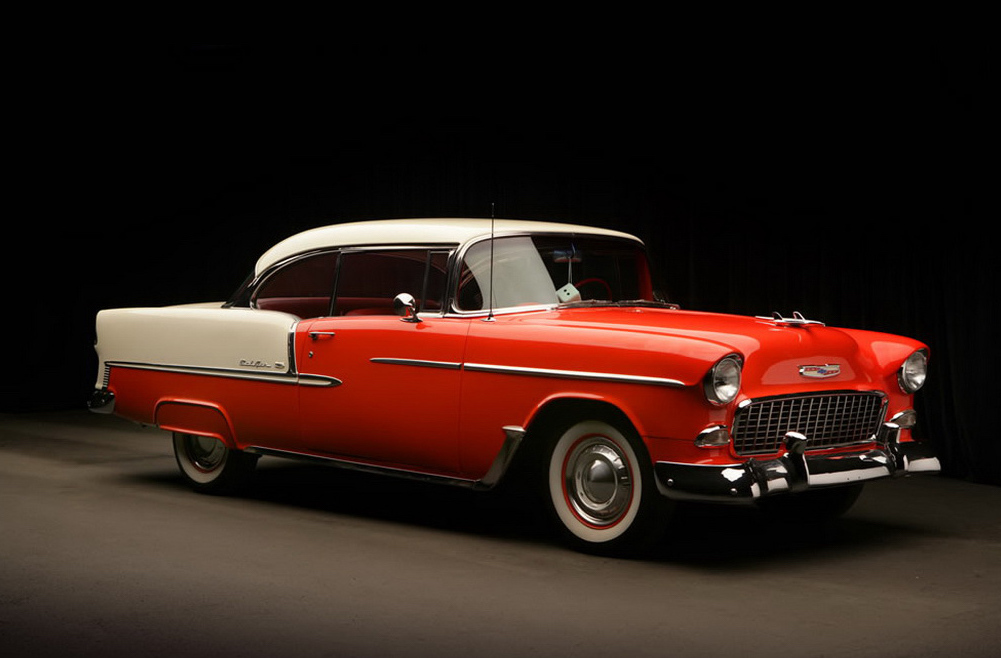
The cars came to symbolise an era of peace, prosperity, freedom, and rock ‘n’ roll, with neat, clean styling, a hint of rear fins, a wraparound windshield and bold, two-tone paintwork.
Chevy’s bold new dawn
While Cole worked on the engine, General Motors’ (GM) styling chief Harvey Earl and Chevrolet’s styling head Clare ‘Mac’ MacKichan oversaw the design of the 1955 model year Chevys.
They wanted to provide a scaled down, and much cheaper, version of GM’s Motorama luxury ‘dream cars’ – a mini-Cadillac at Chevy prices.
The shrouded headlights and frenched-in tail lights with chrome surrounds were pure Cadillac, the grille had a hint of Ferrari, while chrome side trim with a slight hip-dip at the window belt-line opened up a range of two-tone colour options.
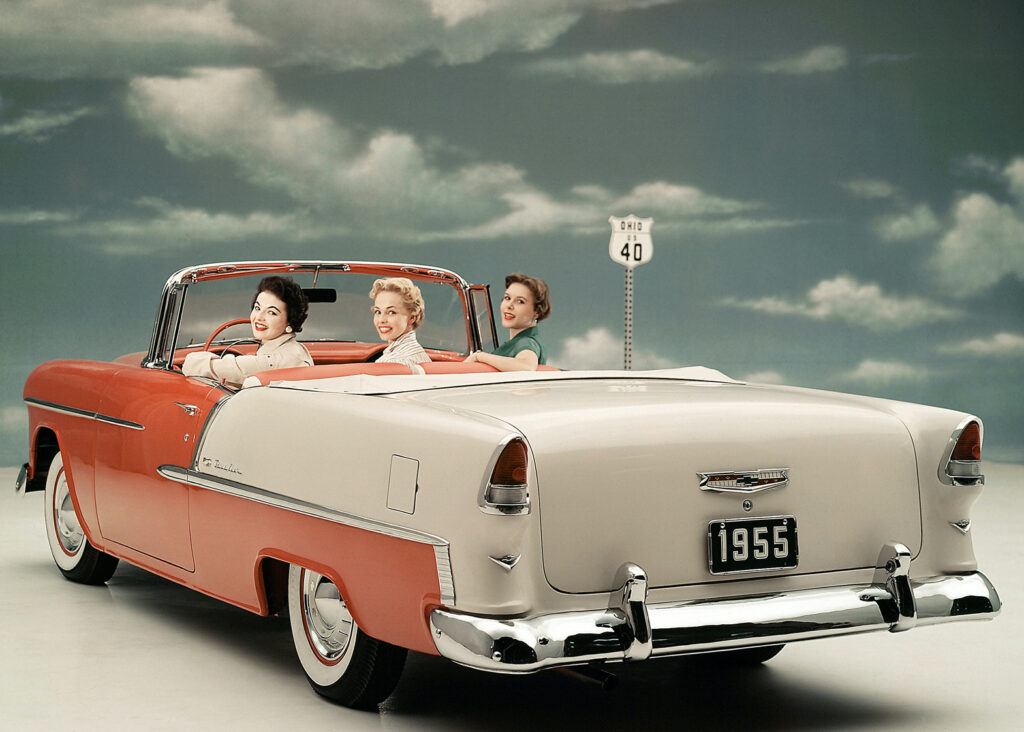
This was no evolution from the 1954 Chevrolets – it was a styling revolution, a bold new vision of affordable family motoring.
The car contained more than 80 per cent new parts from its predecessor, including a 12-volt electrical system for the first time, and Chevrolet general manager Thomas Keating declared that the changes “were greater than have ever been attempted by an automobile manufacturer in one year”.
While the new cars were still offered with the old inline six engines, it was Cole’s V8 that turned the cars – and the top line Bel Air in particular – into something special.
The 265-V8 featured a modern, overhead valve high compression ratio and short stroke design, and was so good it was still in production until 2003.
At launch, the Bel Air was offered with the standard 162hp ‘Turbo Fire’ unit or a 180hp optional Power Pack, with a four-barrel carb and dual exhausts, developed in conjunction with Zora Arkus-Duntov, known as the ‘Godfather of the Corvette’.
Later in 1955, a Super Power Pack with higher compression took power up to 195hp.
Beneath the Bel Air was the base 150 and the mid-priced 210, as well as a station wagon.
This was no longer the typical Chevrolet ‘dad’s car’ – but dads loved them anyway.
Launch of ‘the hot one’
The wraps came off what Chevrolet called ‘the hot one’ in October 1954, with the Bel Air the range’s headline act.
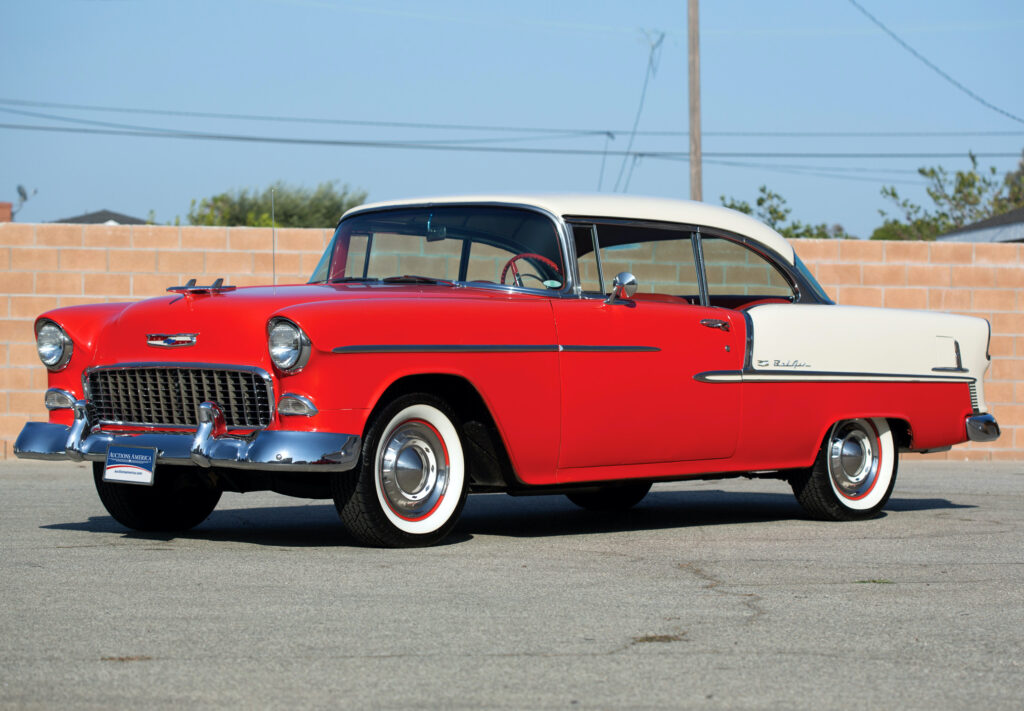
It was distinguished from its cheaper siblings by additional trim, such as interior carpets, extra chrome including spears on the front wings, and stainless steel window mouldings.
Among the bodies on offer were a two or four-door sedan, a two-door sport coupe or convertible, both with shorter roofs and longer rear decks, and the Bel Air Nomad sports wagon.
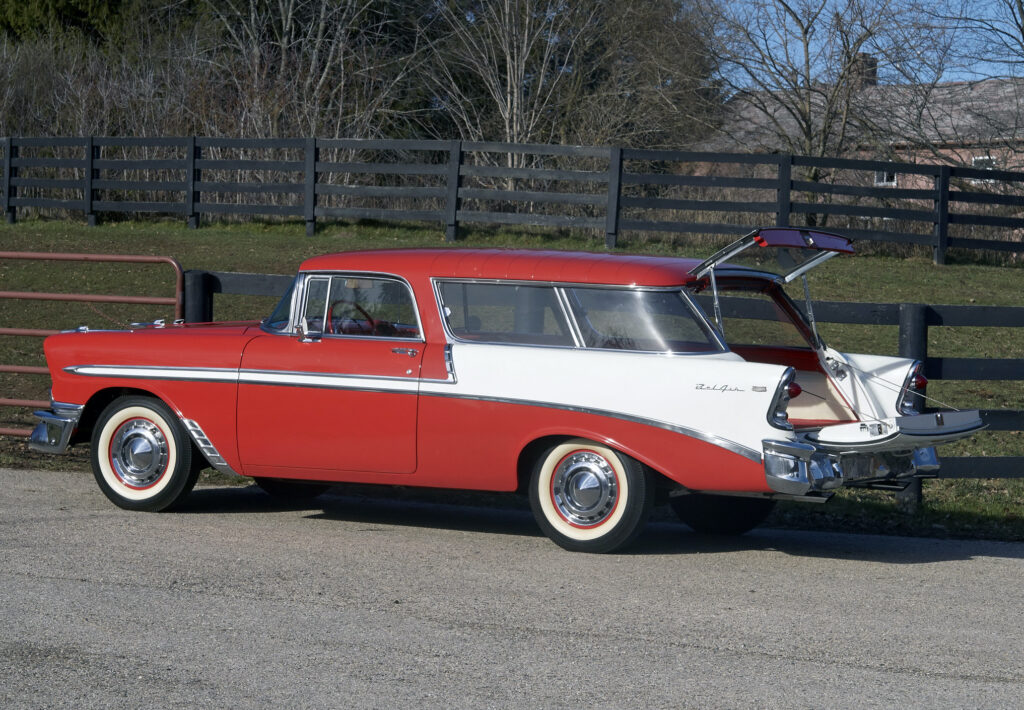
There were new options available, including air conditioning, power steering, windows, seats, and brakes, as well as automatic light dimmers, door handle protectors and ‘wonder bar’ radios.
All of which proves that Chevy was aiming high for a car in the low-price marketplace.
A choice of transmissions was offered – a two-speed Powerglide or a three-speed manual, available with overdrive for the first time.
Inside, the dash was lifted from the Corvette, but with a wide band of chrome mesh added.
In December 1954, Motor Life magazine wrote presciently of the ‘55 Chevy: “Chevrolet’s stylists, engineers and sales personnel are out to give the public exactly what they want in 1955.
“If the public wants an expensive-looking car, the 1955 Chevrolet resembles, more than superficially, expensive older brothers Oldsmobile, Buick, Cadillac.
“If it’s horsepower and a new engine that’s desired, the 1955 Chevy features their new short stroke V-8.
“If it’s low speed acceleration, the 1955 model Powerglide now has a low with a ‘snap’. If it’s the sleek, ‘low’ look, the 1955 Chevy models have been reduced in height.”
Why prescient? Because it quite quickly transpired that Chevrolet had, indeed, given the public exactly what they wanted.
Adrian Flux Classic Car Insurance
The standard V8 could hit 60mph in a brisk 13.9 seconds on its way to a top speed nudging 100mph, easily exceeded by the Power Pack models.
Motor Life noted how “above 20 mph, the (Powerglide) transmission digs in sharply and the Chevy V-8 accelerates from 20 to 60 like a well-tuned sports car”.
It concluded that the “Chevrolet for 1955 is a gathering together of the best mechanical and design features available in the industry today”.
After a quiet start in showrooms, as Chevy customers got to grips with the radically different styling, by the spring of ‘55 a trickle of orders had become a flood.
Production was cranked up, hitting a record 7,902 cars in one day on April 28, and on May 30 actress and singer Dinah Shore – who hosted a TV show sponsored by Chevrolet – rode on the back of a Bel Air convertible pace car at the Indy 500.
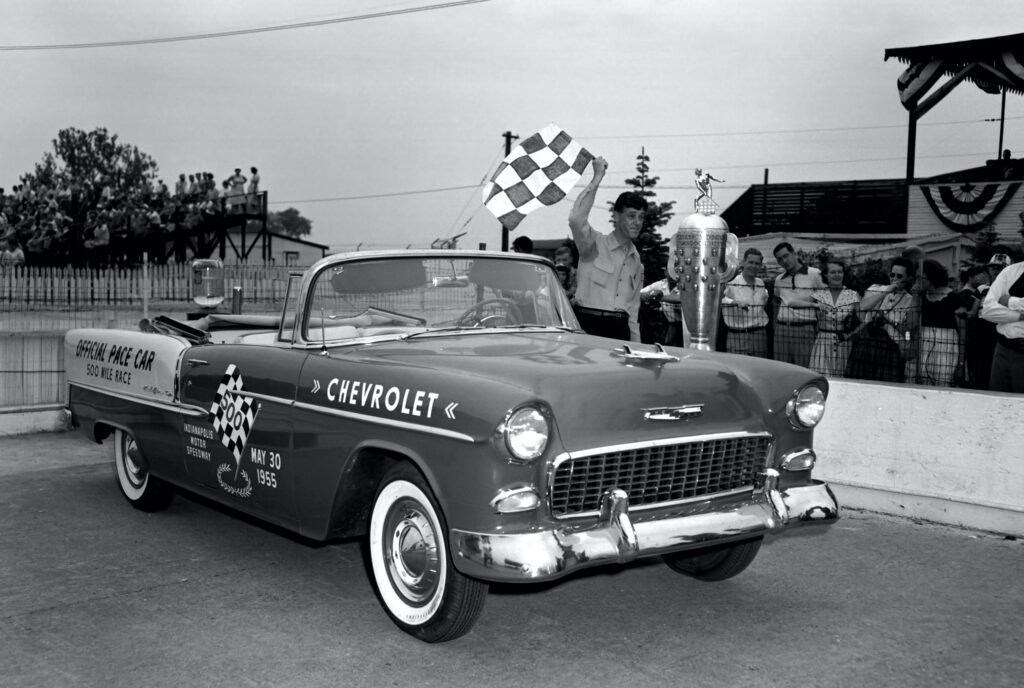
By the end of the year, Chevrolet had grabbed 44 per cent of the low-price car market, selling 1.7million vehicles (including more than 800,000 Bel Airs), 250,000 more than Ford.
Chevrolet Bel Air 1956
If it ain’t broke, don’t fix it very much applied to the 1956 Chevrolet, with only minor changes including a new, full-width grille, which gave the car a more aggressive edge.
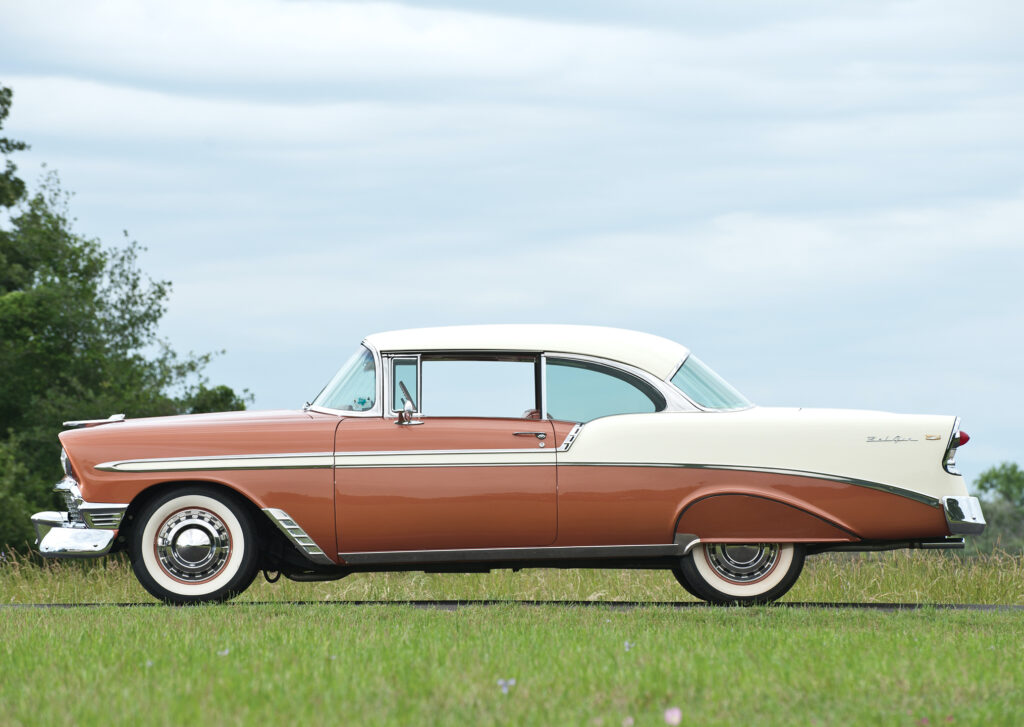
By now, engine tuners and hot rodders had discovered that the V8 was easy to modify for extra power, and Chevrolet’s engineers followed suit, making a 225hp version of the 265 unit available.
As famed automotive writer Tom McChahill noted, “the hot one is even hotter”, describing the V8 as “the best engine in the US”.
In this form, the Chevy would accelerate to 60mph in just 8.9 seconds, reaching 120mph flat out.
“It has the finest breathing engine ever built in America and a camshaft that is absolutely perfect,” he wrote. “Ed Cole, who designed the engine, deserves a medal.”
Chevrolet’s ad men made much of Arkus-Duntov’s record-breaking ascension in a Bel Air of Pikes Peak in the Rocky Mountains, taking 17 minutes and 24.05 seconds and shattering the previous best of 19 minutes plus, set 21 years earlier.
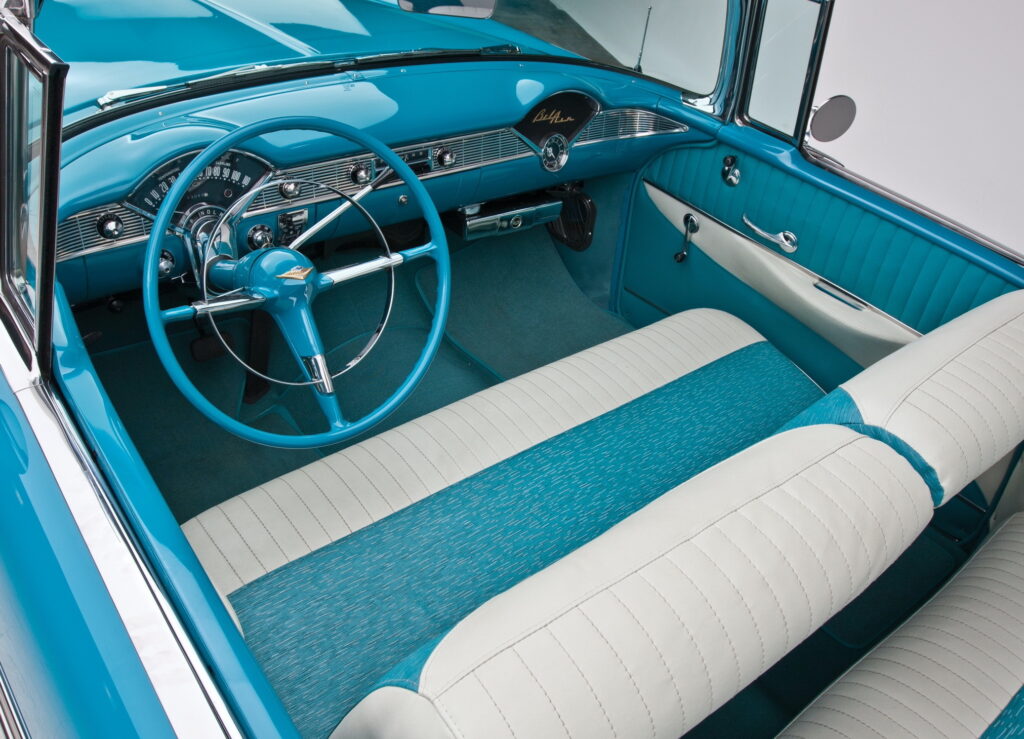
“Nothing without wings climbs like a ‘56 Chevrolet!” ran the adverts. “Ever level off a mountain with just your foot? Just point this new ‘56 Chevy uphill and ease down on the gas.
“In the merest fraction of a second you sense that big bore V8 lengthening its stride. And up you go with a silken rush of power that makes a mountain seem as flat as a roadmap!”
In mid-year, the Super Power Pack took horsepower up to 240, justifying the hype about the ‘hot one’ a little bit more.
Chevy again outsold Ford in 1956, with 1.62million cars sold, of which nearly 700,000 were Bel Air models.
Like our illustration of the Chevrolet Bel Air: glory years of ‘the hot one’ at the beginning of the article?
Download a free high-quality poster version here.
Chevrolet Bel Air 1957 – the special one
With its more extravagant tail fins, larger grille, extra chrome, and twin-rocket hood design, the restyled Chevrolet Bel Air of 1957 is now considered to be best of the bunch – the quintessential ‘50s American car.
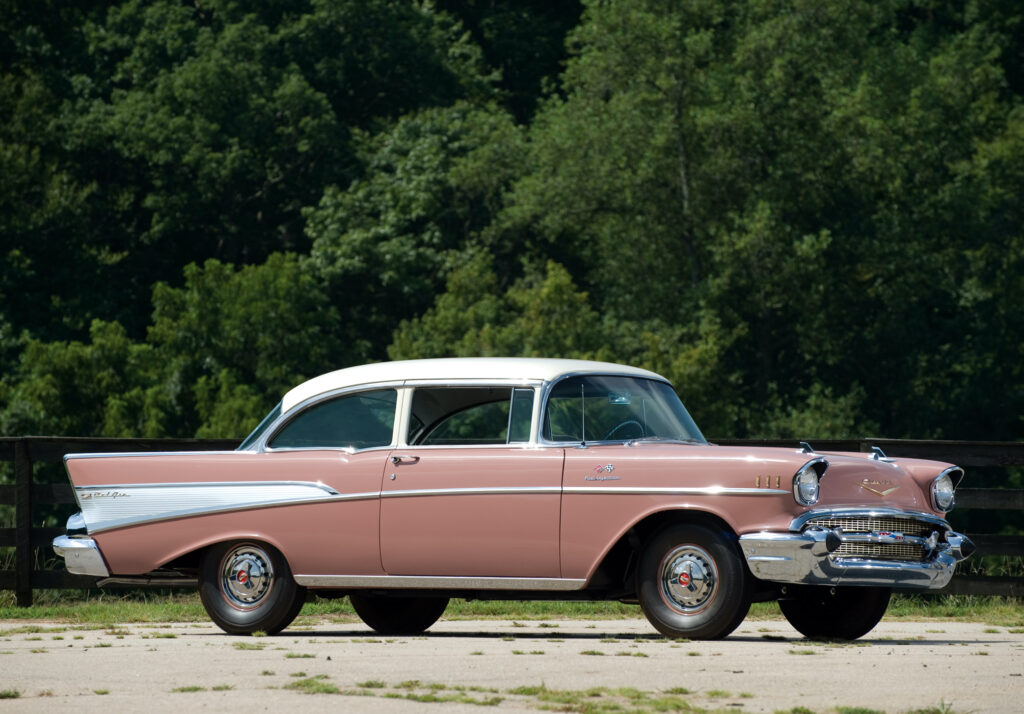
At the time, there were cars with bigger and more extreme fins, and much more chrome, but the bolder new Bel Air stayed the right side of these excesses.
For 1957 the Bel Air was only offered with the V8, which had been bored out to 283cu in (4.6-litres), with carbureted versions now delivering between 185hp and 270hp.
An even hotter version with Rochester Ramjet fuel injection pumped out 283hp, the first production engine to produce 1hp per cubic inch. Naturally, these came at a price, and are now very rare.
It turned the Chevy into a road-ready hot rod, a prized ‘street machine’ that was also popular among drag racers.
A second automatic transmission, the Turboglide, was available as an option alongside the original Powerglide, providing almost imperceptible gear shifts. A three-speed manual was still an option, and the only transmission available on the fuel injected cars until a four-speed was introduced later in the year.
In January 1957, Motor Trend tested a 270hp carbureted Bel Air, and noted that the car still holds the title of “the hottest one” in its field.
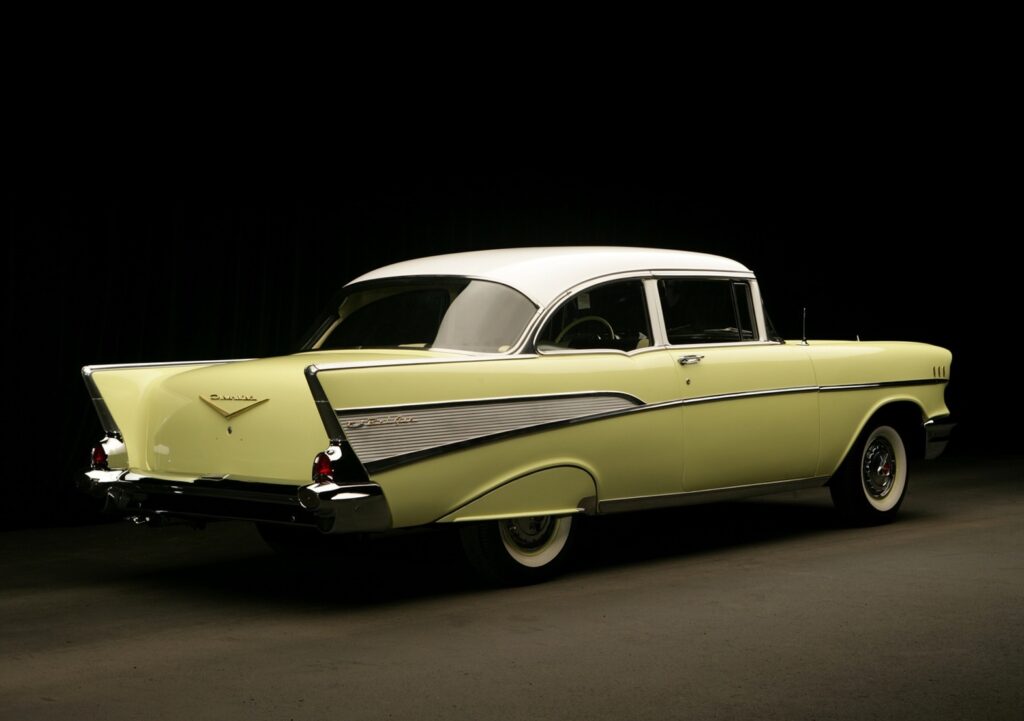
“A car that can almost fly from 45 to 60 (mph) in a mere 2.9 seconds is one that should be capable of keeping you and your family out of trouble,” it wrote.
“Along with the V8’s smoothness, the high quality of interior trim, the softer ride and the use of various components present in bigger GM cars, this can almost make you think you’re in a higher price bracket.”
Although Chevrolet lost out to Ford overall in the low-price sector, by about 30,000 cars, more than 720,000 Bel Airs were sold in 1957 out of a total 1.55million Chevys.
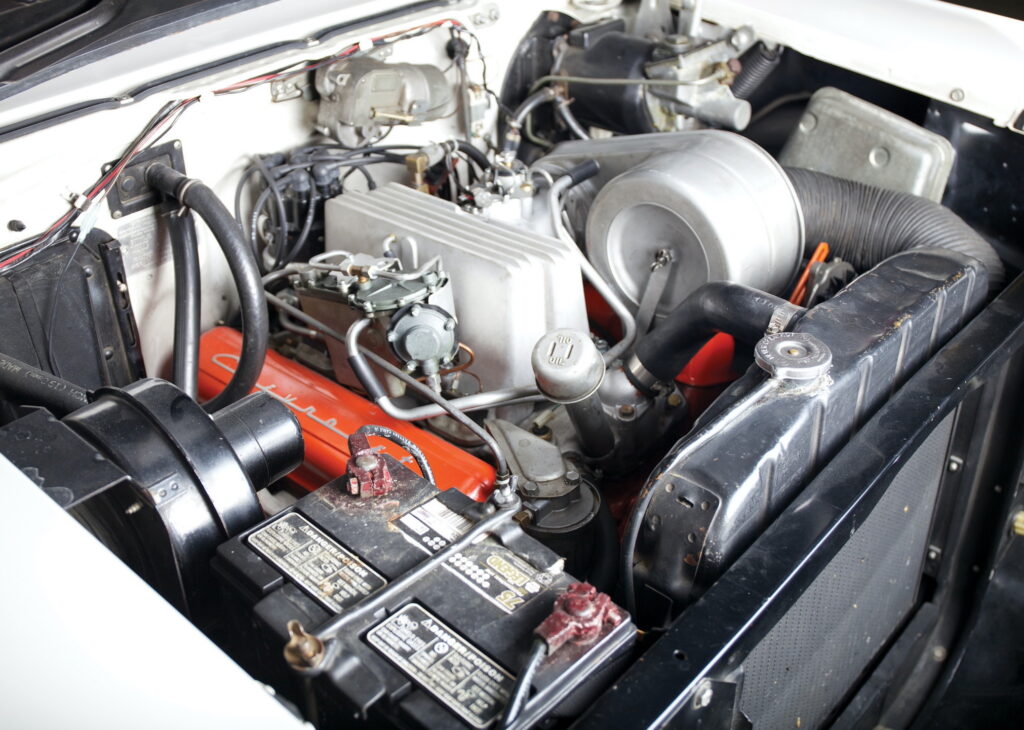
The brief but spectacularly successful Tri-Five series came to an end in 1958 when Chevrolet completely redesigned the Bel Air and its sister cars, making them longer, lower and heavier.
The Bel Air name was attached to a series of Chevrolet cars between 1950 and 1981, but none of them captured the imagination, either at the time or now, as the Tri-Five cars.
A popular used car for several years after their demise, through the ‘60s they were always prominent on the drag strip, often out-performing more modern cars.
Because they were always in demand, it was almost as if they never went away at all, reaching classic status much earlier than most cars do.
While many future classics endure a period in the doldrums, when they are just an ‘old car’, the Tri-Fives never did, regarded fondly by each passing generation.
Today, they embody a golden age of American motoring and, quite possibly, American life itself.


